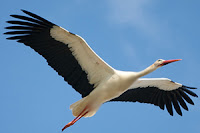The White Stork
The White Stork is the national bird of Germany and Lithuania. It is also set against a yellow and green background the symbol of the city of The Hague, The Netherlands.
If a white stork nests on top of your house, it's supposed to be good luck, it is viewed as bird of good luck, it is not persecuted. Traditionally old wagon wheels were mounted on the roof of a house to encourage the white storks to nest. The White Stork often nests close to human habitation, it often forms small colonies. You can see these today on the tops of houses, churches and other buildings in Germany and Eastern Europe. In Germany, 3,000 of the total 3,400 pairs are in the former East Germany.
The White Storks are large birds that rely heavily on energy efficient soaring flight during migration. Soaring requires the presence of thermal air currents that are not found over water. White Storks are therefore reluctant to fly across large bodies of water such as the Mediterranean Sea to reach their wintering grounds in tropical areas. They solve this problem by having the bulk of the European population split into two distinct migratory routes. Western birds cross the Mediterranean at the Straits of Gibraltar, while most of the eastern birds cross the Bosporus and circle around the Mediterranean through the Middle East. Migration is highly synchronized and flocks contain as many as 11,000 individuals. Birds migrating from Denmark to South Africa and back again may cover a total distance of 20,000 km. Small numbers of birds cross the Mediterranean directly by flying south from the southern tips of Italy and Greece. Some western European White Storks join the Asiatic subspecies asiatica to winter in India.
Choosing to visit Germany can be an educational and historically enriching experience for the whole family. Four must see cities in Germany are Berlin, Frankfurt, Munich and Hamburg.
Stopping in Berlin
A famous Berlin landmark is the Berlin Wall. This stop will provide for an education about Germany's history and how the dismantling of the Wall has affected the German people. Other exhibits in Berlin are the Jewish Museum, the Perganon ancient history museum, The Brandenburg Gate monument, the Atlas archaeological museum, The Story of Museum history exhibit and the Klusor Wilhelm Memorial Church ruins from bombings during World War II. The New Synagogue of Berlin features an exhibit of the Berlin Jewish culture. Wintergarten Variete showcases a world famous cabaret show. The Berlin Cathedral is a beautiful Protestant church and will delight architecture lovers visiting Berlin. The art lover will not want to miss the National Gallery featuring eighteenth, nineteenth and twentieth century art, and the Tacheles hosting works by trendy German artists.
Stopping in Berlin
A famous Berlin landmark is the Berlin Wall. This stop will provide for an education about Germany's history and how the dismantling of the Wall has affected the German people. Other exhibits in Berlin are the Jewish Museum, the Perganon ancient history museum, The Brandenburg Gate monument, the Atlas archaeological museum, The Story of Museum history exhibit and the Klusor Wilhelm Memorial Church ruins from bombings during World War II. The New Synagogue of Berlin features an exhibit of the Berlin Jewish culture. Wintergarten Variete showcases a world famous cabaret show. The Berlin Cathedral is a beautiful Protestant church and will delight architecture lovers visiting Berlin. The art lover will not want to miss the National Gallery featuring eighteenth, nineteenth and twentieth century art, and the Tacheles hosting works by trendy German artists.
While in Frankfurt
Visitors to Frankfurt will want to experience the Frankfurt Zoo, St. Leonard Church, the Senckenberg Natural History Museum, the German Architecture Museum, and the Frankfurt Historical Museum. Other popular attractions are the Goethe House, home and museum of the legendary writer, Johann Wolfgang von Goethe, and Leibieghaus, a unique castle-like art museum located in Frankfurt.
Munich attractions that are popular with tourists are Staatlickes Hofbrauhaus a sixteenth century famous beer hall and the English Garden, a classic scenic park featuring classic English horticulture as well as Greek, Chinese and Japanese exhibits. Don't miss Viktualienmarkt an outdoor marketplace featuring German crafts. The Old Pinakothek art gallery is a popular stop. Religious enthusiasts will enjoy the Church of Our Lady, a fifteenth century cathedral with domed towers as well as St. Peter's Church which offers amazing scenic photo opportunities. Munich is also home to the BMW factory museum, a great stop for the automobile enthusiast.
Touring Hamburg
Hamburg also offers popular tourists stops in the form of art galleries, historical exhibits and museums. Hamburg is a major transportation hub in Northern Germany and is one of the most affluent cities in Europe. It has become a media and industrial center, with plants and facilities belonging to Airbus, Blohm + Voss and Aurubis. The radio and television broadcaster Norddeutscher Rundfunk and publishers such as Gruner + Jahr and Spiegel-Verlag are pillars of the important media industry in Hamburg. In total there are more than 120,000 enterprises. The city is a major tourist destination both for domestic and overseas visitors, receiving about 7.7 million overnight stays in 2008.
An ideal country to visit with whole family log on : http://www.germany-tourism.co.uk/ and
http://ets-frankfurt.com/






